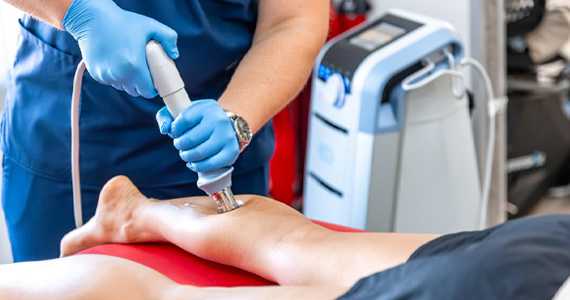Shockwave Therapy vs. Traditional Pain Treatments: Which is Right for You?
Shockwave Therapy vs. Traditional Pain Treatments: Which is Right for You?
 For those struggling with pain and loss of mobility, selecting the right treatment option can be daunting. With so many choices, it is essential to consider the advantages of new methods, such as shockwave therapy, against more traditional approaches. At Grandview Physiotherapy, we’re here to help you make an informed choice for your health and healing.
For those struggling with pain and loss of mobility, selecting the right treatment option can be daunting. With so many choices, it is essential to consider the advantages of new methods, such as shockwave therapy, against more traditional approaches. At Grandview Physiotherapy, we’re here to help you make an informed choice for your health and healing.
What is Shockwave Therapy?
Shockwave therapy is a type of non-invasive treatment where acoustic waves are used to promote healing in sore tissues. Initially designed for addressing kidney stones, it has gained popularity as a solution for musculoskeletal conditions, including:
- Plantar fasciitis
- Tennis elbow
- Calcific shoulder tendinitis
- Achilles tendinopathy
- Chronic back pain
Shockwave therapy alleviates pain by promoting blood circulation, dissolving scar tissue, and facilitating cellular repair. This addresses pain at the source and speeds up healing.
What are Traditional Pain Treatments?
Traditional treatment methods for pain and inflammation have been tried and tested over time. Common options include:
Physical therapy: Strengthening and conditioning exercises and manual methods to keep you nimble.
Medications: Nonprescription or prescription drugs like NSAIDs and muscle relaxants.
Cortisone Injections: These are anti-inflammatory injections to decrease swelling and pain.
Heat/Cold therapy: heat helps to stretch the arms or cold for swelling.
Massage: Apply pressure to muscles, tendons, or ligaments to positively impact health and well-being.
Comparing the Two: Key Factors to Consider
Effectiveness
- Chronic conditions and other injuries that have not responded well to other treatments are treated most effectively by shockwave therapy. A high success rate in treating plantar fasciitis and tendinopathy has been reported.
- Conventional remedies are widely recognized and versatile in treating acute injuries and chronic pain.
Treatment Duration
- In most cases, three to six shockwave applications of 15-to-20 minutes each are recommended.
- Other treatments, such as physiotherapy or medication, may take longer to work, and you might need them regularly.
Side Effects and Risks
- Most people who owe shockwave therapy a try does not notice any side effects, but if you have mild pain or the skin over the treated area is red for some days.
- Conventional treatments, including medications and injections, can carry potential side effects of stomach upset, dependency, or tissue injury.
Cost
- Although shockwave therapy is more costly per session, fewer sessions required can range it to a cost-effective remedy.
- Medication is more affordable but may necessitate taking it for an extended period.
What Is The Right Treatment For You?
Whether you prefer some other traditional relief treatments or undergoing shockwave therapy over others will ultimately depend on your condition, pain levels, and personal preferences. Think about these scenarios:
Extracorporeal Shockwave Therapy Is the Answer If:
Your current state is either a chronic or resistant-to-treatment condition. Otherwise, you are looking for an alternate treatment with less downtime and is not invasive.
Use Traditional Treatments For Chronic Pain If:
You’re managing acute pain, prefer a gradual approach like physiotherapy, or need a temporary solution while exploring long-term options.
There is no way pain has to be forever. Fortunately, technology has made strides in the right direction, and treatment is available. For additional information about shockwave treatment or another sort of pain management plan you wish to learn more about, then phone Grandview Physiotherapy right now. We would love to partner with you on this amazing journey of moving well and maximizing life without pain.
